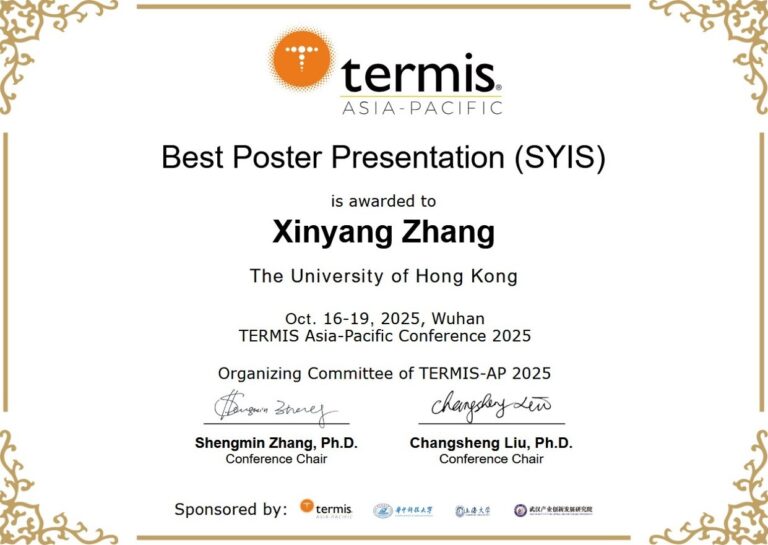Miss Xinyang Zhang Wins Best Poster Presentation Award at the 2025 TERMIS-AP Conference
Miss Xinyang ZHANG, a final-year PhD student supervised by Professor Min Wang in the Department of Mechanical Engineering, has won the Best Poster Presentation Award (SYIS) at the Tissue Engineering and Regenerative Medicine International Society Asia-Pacific Conference 2025 (2025 TERMIS-AP) which was held on October 16-19, 2025 at the China Optics Valley Convention and Exhibition Center in Wuhan, China. TERMIS-AP conferences are among the most influential academic conferences in the field of tissue engineering and regenerative medicine in the Asia-Pacific region. 2025 TERMIS-AP brought together more than 2,000 researchers, clinicians, industry experts, and regulatory professionals from across the Asia-Pacific region to discuss the latest advances in biomaterials, stem cells, tissue engineering, and regenerative medicine. It offered a rich platform for knowledge exchange, networking and collaboration, fostering global cooperation and shaping future directions for R & D in tissue engineering and regenerative medicine.
Miss Zhang’s presentation in this conference is entitled “Antioxidant-functionalized Hydrogel Scaffolds Fabricated by 3D Printing for Liver Tissue Regeneration”, which is based on her PhD work conducted at HKU. In this study, antioxidant hydrogel scaffolds were developed for liver tissue engineering by incorporating tannic acid (TA) into hierarchically structured, 3D printed chitosan-based scaffolds. The scaffolds were made using printable hydrogel inks consisting of chitosan methacrylate and xanthan gum, which were cross-linked and loaded with different amounts of TA. TA provided antioxidative, anti-inflammatory and antibacterial functions to the scaffolds. The printing inks exhibited good rheological properties and good printability, and 3D printed scaffolds displayed high fidelity and mechanical stability, as well as suitable water absorption and biodegradation behavior. In vitro experiments using fibroblasts and hepatocytes showed high cell viability, suggesting good biocompatibility of scaffolds. Moreover, antioxidant assays demonstrated that TA-loaded scaffolds effectively scavenged free radicals, with higher TA contents leading to stronger antioxidative performance, indicating their high potential for liver tissue regeneration applications.

The award certificate for Miss Xinyang Zhang
